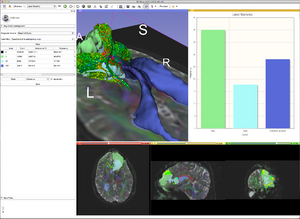Difference between revisions of "Documentation/4.0/SlicerApplication/HardwareConfiguration"
From Slicer Wiki
(Prepend documentation/versioncheck template. See http://na-mic.org/Mantis/view.php?id=2887) |
|||
| (23 intermediate revisions by 4 users not shown) | |||
| Line 1: | Line 1: | ||
| + | <noinclude>{{documentation/versioncheck}}</noinclude> | ||
<!-- ---------------------------- --> | <!-- ---------------------------- --> | ||
| − | {{documentation/{{documentation/version}}/ | + | {{documentation/{{documentation/version}}/slicerapplication-header}} |
<!-- ---------------------------- --> | <!-- ---------------------------- --> | ||
| − | = | + | [[Image:Screen Shot 2012-02-09 at 10.11.08 AM.png|right|thumb|300px|Charting was introduced to Slicer 4 in February of 2012]] |
| + | =Introduction= | ||
| + | 3D Slicer is a cross platform desktop application for | ||
| + | *image visualization and | ||
| + | *image processing | ||
| + | *3D Slicer is a free, open source package available as an executable for multiple operating systems (Windows, MAC, Linux). | ||
| − | + | * Computers running 3d Slicer need enough memory and graphics capabilities to hold both the original data and the processing results in their memory. | |
| − | Slicer | ||
| − | =Hardware Configuration= | + | =Recommended Hardware Configuration= |
| − | * | + | * Memory: more than '''4GB''' (8 or more are recommended). |
| − | + | * Display: a minimum resolution of '''1024 by 768''' (1280 by 1024 or better is recommended). | |
| − | * | + | * '''Dedicated''' graphics hardware and memory (1GB is recommended). |
| + | * Many computations in Slicer are multi-threaded and will benefit from multi core, multi CPU configurations. | ||
| + | * Interface device: a three button mouse with scroll wheel is recommended. For other devices, see [[Documentation/4.0/SlicerApplication/MouseandKeyboardShortcuts#Rotate.2C_Zoom.2C_Pan|here]] for "how to". | ||
| + | * Internet connection to access online documentation of modules and tutorials | ||
=Recommended OS versions= | =Recommended OS versions= | ||
| − | + | *Windows 7 64bit | |
| − | -Mac OS X Lion | + | *Mac OS X Lion |
| − | + | *Linux: recent versions of popular distributions should work. Ubuntu and Fedora are the most widely used distribution among the developers. | |
| + | |||
| + | =Examples of Working Configurations= | ||
| + | ==Feb 2012== | ||
| + | The entries below are hardware/OS combinations which will work with the downloaded executable for the current Slicer 4 release. This are just examples of working configurations. | ||
| + | *Apple: 15-inch MacBook Pro, 2.3 Ghz Intel Core i7, 8GB Memory, AMD Radeon HD 6750M 1024MB, Mac OS X Lion 10.7.3 | ||
| + | *Windows: Generic Desktop, 3.4 GHz Intel Core i7, 16GB Memory, AMD Radeon HD 5700, Windows 7 Professional 64 bit | ||
| + | *Linux: Dell Precision m4500, Quad-Core Intel Core i7, 16GB Memory, NVIDIA® Quadro® FX 880M, Ubuntu 10.10 | ||
| + | |||
| + | |||
| + | |||
| + | |||
| + | <!-- ---------------------------- --> | ||
| + | {{documentation/{{documentation/version}}/slicerapplication-footer}} | ||
| + | <!-- ---------------------------- --> | ||
Latest revision as of 07:29, 14 June 2013
Home < Documentation < 4.0 < SlicerApplication < HardwareConfiguration
|
For the latest Slicer documentation, visit the read-the-docs. |
Introduction
3D Slicer is a cross platform desktop application for
- image visualization and
- image processing
- 3D Slicer is a free, open source package available as an executable for multiple operating systems (Windows, MAC, Linux).
- Computers running 3d Slicer need enough memory and graphics capabilities to hold both the original data and the processing results in their memory.
Recommended Hardware Configuration
- Memory: more than 4GB (8 or more are recommended).
- Display: a minimum resolution of 1024 by 768 (1280 by 1024 or better is recommended).
- Dedicated graphics hardware and memory (1GB is recommended).
- Many computations in Slicer are multi-threaded and will benefit from multi core, multi CPU configurations.
- Interface device: a three button mouse with scroll wheel is recommended. For other devices, see here for "how to".
- Internet connection to access online documentation of modules and tutorials
Recommended OS versions
- Windows 7 64bit
- Mac OS X Lion
- Linux: recent versions of popular distributions should work. Ubuntu and Fedora are the most widely used distribution among the developers.
Examples of Working Configurations
Feb 2012
The entries below are hardware/OS combinations which will work with the downloaded executable for the current Slicer 4 release. This are just examples of working configurations.
- Apple: 15-inch MacBook Pro, 2.3 Ghz Intel Core i7, 8GB Memory, AMD Radeon HD 6750M 1024MB, Mac OS X Lion 10.7.3
- Windows: Generic Desktop, 3.4 GHz Intel Core i7, 16GB Memory, AMD Radeon HD 5700, Windows 7 Professional 64 bit
- Linux: Dell Precision m4500, Quad-Core Intel Core i7, 16GB Memory, NVIDIA® Quadro® FX 880M, Ubuntu 10.10
